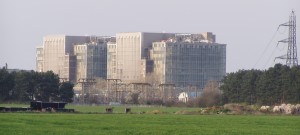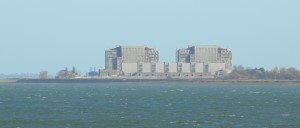Bradwell Nuclear Power Station

Proposals to build a nuclear power station
In 1955 the Government decided
to build nuclear power stations in the UK.
Two sites were considered, one
was at Berkeley in the West of England and the other was at Bradwell
on Sea.
The 24 acre site used was
formerly a World War Two airfield that had been returned to
agriculture.
The adjacent Blackwater
estuary was important to the station as it provided the 222 million
litres of cold water per hour that were required for cooling.
Tom Driberg , the local MP who
lived at Bradwell led a campaign against the Power Station which
split public support although most local people favoured the
building.
A public
enquiry was held which lasted only 5 days which resulted in approval
only 8 months after the first announcement of the proposals.
Building
Building took nearly 5 years
with work starting in December 1957.
Many new houses were
constructed in Tillingham, Latchingdon and Southminster to cater for
the builders and then the new employees.
Many of the larger items were
shipped in to a specially built jetty built into the River
Blackwater with the rest transported by road on the improved
Latchingdon to Bradwell road. This proved an initial problem as the
arrival of the first large boiler by road was on a hot day and the
combined weight of boiler and lorry proved to great for the hot
tarmac. From then on other large loads were transported in the early
morning or evenings when the roads were cooler.
Opening
Bradwell Power Station was one
of the first magnox power stations in the UK.
The first reactor started to
supply electricity to the national grid on 1 July 1962 closely
followed by the second reactor on 12 November 1962.
Although expected to last 25
years it continued generating electricity for 40 years eventually
ceasing to generate electricity in March 2002.
The formal opening ceremony
was held on 5th April 1963 by Sir John Ruggles Brise who was the
Lord Lieutenant of Essex
Operation
The station had two magnox
reactors powered by natural uranium with 4 cooling towers using
carbon dioxide coolant.
The building comprised of two
large blocks with smaller buildings and distribution points.
Spent fuel roads were stored
on the site in a water pool for about 90 days until the
radiation had decreased sufficiently for them to be transported to
Sellafield in Cumbria for reprocessing.
The rods were loaded into
specially constructed 43 tonne flasks made from lead and steel.
These flasks were transported by road to a purpose built compound at
Southminster railway station and then taken by goods train via the
rail network to Cumbria.
The station
generated 242 megawatts of electricity sufficient to completely
power the nearby Essex towns of Chelmsford , Colchester and the
conurbation of Southend on Sea. During it's lifetime just under 60
terra watts of electricity was generated.

The Power Station viewed from the River
Blackwater
Terrorism
The increase of terrorism in
the last few years of the active life of the power station led to
increased security and prompted a statement in the House of Commons
Brian Wilson, minister for
energy and construction, said: "The Government has undertaken an
assessment of potential terrorist acts against all civil nuclear
power stations.
Closure
On Thursday 28 March 2002 the
station ceased generating electricity and was formally closed by The
Lord Lieutenant of Essex, Lord Braybrooke
As the main employer in the
district, providing 450 jobs, its closure proved a negative impact
on the local economy with 250 jobs existing in 2007 in a program of
steady decline due to the decommissioning activity.
Since the current phase of
decommissioning was completed in 2009 there has been little activity
on site other than structural maintenance and safety checks until
2095 when the site can be safely cleared.
New Power Station
A proposal
for Bradwell B Power Station is under consideration although any construction
would be well into the future.

